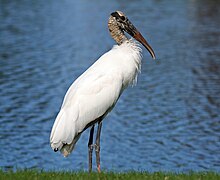Mycteria americana
| Wood stork | |
|---|---|
 |
|
| Pond, Tampa Bay, Florida |
|
| Scientific classification | |
| Kingdom: | Animalia |
| Phylum: | Chordata |
| Class: | Aves |
| Order: | Ciconiiformes |
| Family: | Ciconiidae |
| Genus: | Mycteria |
| Species: | americana |
| Binomial name | |
|
Mycteria americana Linnaeus, 1758 |
|
The wood stork (Mycteria americana) is a large American wading bird in the stork family Ciconiidae. It was formerly called the "wood ibis", though it is not an ibis. As of June 26, 2014 it is classified as a threatened species by the U.S. Fish & Wildlife Service.
The adult is a large bird which stands 83 to 115 cm (33–45 in) tall and spans 140 to 180 cm (55–71 in) across the wings. Males typically weigh 2.5 to 3.3 kg (5.5–7.3 lb), with a mean weight of 2.7 kg (6.0 lb); females weigh 2.0 to 2.8 kg (4.4–6.2 lb), with a mean weight of 2.42 kg (5.3 lb). Another mean estimated weight for the species was 2.64 kg (5.8 lb). However, exceptionally large males are sometimes found and these can weigh up to 4.5 kg (9.9 lb). It appears all white on the ground, with blackish-gray legs and pink feet. In flight, the trailing edge of the wings is black. The head is dark brown with a bald, black face, and the thick down-curved bill is dusky yellow. Juvenile birds are a duller version of the adult, generally browner on the neck, and with a paler bill. The bare head and the long bill, which can measure up to 25.5 cm (10.0 in) in length, render the wood stork distinctive from other large waders in its range. The standard scientific measurements of the wood stork are as follows: the wing is 42–49 cm (17–19 in), the culmen is 19–25 cm (7.5–9.8 in) and the tarsus is 17.5–21.5 cm (6.9–8.5 in).
This is a subtropical and tropical species which breeds in much of South America, Central America and the Caribbean. The wood stork is the only stork that presently breeds in North America. In the United States there is a small breeding population in Florida, Georgia, and South Carolina, along with a recently discovered rookery in southeastern North Carolina. After a successful three-decade conservation effort resulting in an increased population in the southeastern United States, the wood stork was removed from the endangered species list and upgraded to threatened on June 26, 2014. Similarly, in the state of Santa Catarina, Brazil, its decline seems to have been reversed: after an absence between the late 1960s and the mid-1990s, the species is now again regularly encountered there, in particular in the Tubarão River region. It is likely that the Paraná River region's wetlands served as a stronghold of the species, from where it is now re-colonizing some of its former haunts. Globally, it is considered a species of Least Concern by the IUCN due to its large range.
...
Wikipedia

